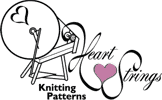
|
HeartStrings FiberArts
Inspiration & Patterns for Wearable Art in Timeless Styles |
| What's New Gallery Catalog Resources Meet Jackie E-S |
♥ PRODUCTS ♥The Pattern CollectionsEasy Knitting Scarves/Stoles Faroese Shawls Other Shawl Shapes Sweaters & Vests Socks & Fun Footwear For the Hands Neck & Up Coverings For the Man For Baby Home Decor Jewelry Minis and Miscellany Bookmarks Toys Holidays & Seasons Comfort Collection I Hate to Purl All Beaded Patterns PDF Pattern Catalog Patterns by Yarn Weight Tutorials ♥ SHOPPING ♥Downloadable PatternsRavelry KnitHeartStrings Kits and Supplies ♥ STAY IN TOUCH ♥Newsletter ArchiveJackie's Blog ♥ A GIFT FOR YOU ♥
"Your patterns are just fabulous ... unique and yet based on tradition."
- Jennifer C.
"I just love the simplicity of your patterns and the complexity of their appearance."
- Maureen M.
"
"I enjoy your website. It is easy to use and full of information ..."
- Debby L.
"... I love Heartstrings patterns. They are clear and well presented and Jackie Erickson-Schweitzer, the designer, is just a lovely, inspiring woman - well worth supporting by the purchase of the pattern."
- Kimberly L.
|
"Lever-action" KnittingLess wasted motion means quicker knitting and reducing CTS risk
|

Starting position
|

Flex outwards
|

Catch needle point
|
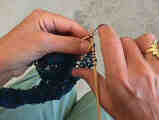
Wrap around point
|
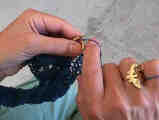
Bring stitch through
|
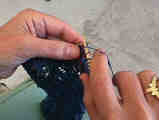
Form new stitch
|
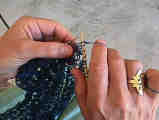
Take new stitch off
|
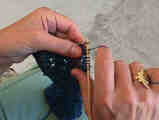
Ready to begin next stitch
|
The photos are also available as an animated sequence prepared by Elaine Norris.
As a comparison, in the Continental, or German style of knitting, the yarn is held in the left hand, and the yarn is "picked" or scooped up by the right-hand needle point. The Continental method reminds me of crocheting, and it is quite natural to me as well. There likewise are efficiency tips that can be applied to this style of knitting by eliminating wasted motion, such as keeping your yarn tensioned close to the needle points.
A more detailed explanation of the "lever-action" style of English knitting - with enlarged pictures
- Tension yarn across/around fingers in right hand the way you would normally, except make sure that yarn passes across tipmost joint of your index finger (the one next to your thumb). Note: I am a vicious nail-biter, which will be very apparent in these pictures. It has been a particularly stressful week at my "real" job, and the nails have definitely taken their toll. You just don't know what a sacrifice I am making to let you see this embarrassment, but I know several of you are anxiously awaiting these pics!
-
Support right-hand knitting needle in some way. Since I generally use
circular knitting needles, or short straight or double pointed needles, I
support the needle with my right thumb. For this type of support, my thumb
is under the right-hand needle as shown
here
If using long straight needles, I could support the needle
under my arm, or in a knitting belt, and just let my thumb stay relaxed above the knitting.
To begin with, the right index finger is flexed toward you, and your hands are positioned close to the needle tips, as pictured here. The pictures show a knit stitch being made, i.e. the working yarn is held in back of the right needle, and the right needle tip inserted from left to right into the front loop of the stitch on the left needle. -
Flex the index finger with the yarn
outward,
then
slightly sideways to the left
and catching the tip of the right hand needle, and complete the
counter-clockwise movement
around the tip. Then
retract
the index finger back again toward your hand.
This sequence of steps is the "lever action" I was referring to. - Proceed as usual, forming the new stitch on the right hand needle by bringing the wrapped yarn through the old stitch, and removing the old stitch from the left needle.
Repeat these steps for each stitch.
The lever action is accomplished in a similar way for a purl stitch, the difference of course being that the working yarn is held to begin with in front of the right needle, and the right needle tip is inserted from right to left into the front loop of the stitch on the left needle.
Animation
The picture sequence can also be viewed in another window as an animated gif. Thanks to Elaine Norris for preparing this animation from the original photos.
- Higher resolution option (473 Kb file): Lever Action Knitting Animation
- Lower resolution (207 Kb file): Lever Action Knitting Animation Downsized - If you are on a slower dial-up connection, choose this option to reduce your download time.
I am a slow knitter and was perusing the internet to find ways to improve. It was a zig-zag path that led me to your site, and I am so grateful to learn your lever-action method. My technique is similar but i 'throw' more than I now know is necessary. I learn best by seeing something demonstrated and appreciate your thorough visual for this method. Thank you so much!
Return to Index of Jackie E-S Articles & Tips.
|



